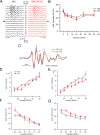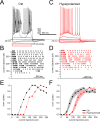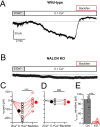The Na+ leak channel NALCN controls spontaneous activity and mediates synaptic modulation by α2-adrenergic receptors in auditory neurons
- PMID: 38197879
- PMCID: PMC10945507
- DOI: 10.7554/eLife.89520
The Na+ leak channel NALCN controls spontaneous activity and mediates synaptic modulation by α2-adrenergic receptors in auditory neurons
Abstract
Cartwheel interneurons of the dorsal cochlear nucleus (DCN) potently suppress multisensory signals that converge with primary auditory afferent input, and thus regulate auditory processing. Noradrenergic fibers from locus coeruleus project to the DCN, and α2-adrenergic receptors inhibit spontaneous spike activity but simultaneously enhance synaptic strength in cartwheel cells, a dual effect leading to enhanced signal-to-noise for inhibition. However, the ionic mechanism of this striking modulation is unknown. We generated a glycinergic neuron-specific knockout of the Na+ leak channel NALCN in mice and found that its presence was required for spontaneous firing in cartwheel cells. Activation of α2-adrenergic receptors inhibited both NALCN and spike generation, and this modulation was absent in the NALCN knockout. Moreover, α2-dependent enhancement of synaptic strength was also absent in the knockout. GABAB receptors mediated inhibition through NALCN as well, acting on the same population of channels as α2 receptors, suggesting close apposition of both receptor subtypes with NALCN. Thus, multiple neuromodulatory systems determine the impact of synaptic inhibition by suppressing the excitatory leak channel, NALCN.
Keywords: GPCR; adrenergic; auditory; inhibition; interneuron; mouse; neuroscience.
© 2023, Ngodup, Irie et al.
Conflict of interest statement
TN, TI, SE, LT No competing interests declared
Figures











Update of
-
The Na+ leak channel NALCN controls spontaneous activity and mediates synaptic modulation by α2-adrenergic receptors in auditory neurons.bioRxiv [Preprint]. 2023 Nov 8:2023.06.23.546323. doi: 10.1101/2023.06.23.546323. bioRxiv. 2023. Update in: Elife. 2024 Jan 10;12:RP89520. doi: 10.7554/eLife.89520. PMID: 37987013 Free PMC article. Updated. Preprint.
Similar articles
-
The Na+ leak channel NALCN controls spontaneous activity and mediates synaptic modulation by α2-adrenergic receptors in auditory neurons.bioRxiv [Preprint]. 2023 Nov 8:2023.06.23.546323. doi: 10.1101/2023.06.23.546323. bioRxiv. 2023. Update in: Elife. 2024 Jan 10;12:RP89520. doi: 10.7554/eLife.89520. PMID: 37987013 Free PMC article. Updated. Preprint.
-
ATP-sensitive K+ channels control the spontaneous firing of a glycinergic interneuron in the auditory brainstem.J Physiol. 2021 Mar;599(5):1611-1630. doi: 10.1113/JP280233. Epub 2021 Jan 13. J Physiol. 2021. PMID: 33369743
-
Gi/o protein-coupled receptors in dopamine neurons inhibit the sodium leak channel NALCN.Elife. 2018 Dec 17;7:e40984. doi: 10.7554/eLife.40984. Elife. 2018. PMID: 30556810 Free PMC article.
-
New insights into the physiology and pathophysiology of the atypical sodium leak channel NALCN.Physiol Rev. 2024 Jan 1;104(1):399-472. doi: 10.1152/physrev.00014.2022. Epub 2023 Aug 24. Physiol Rev. 2024. PMID: 37615954 Review.
-
The ion channels and synapses responsible for the physiological diversity of mammalian lower brainstem auditory neurons.Hear Res. 2019 May;376:33-46. doi: 10.1016/j.heares.2018.12.011. Epub 2018 Dec 26. Hear Res. 2019. PMID: 30606624 Review.
Cited by
-
Fusiform Cells in the Dorsal Cochlear Nucleus Change Intrinsic Electrophysiological Properties and Morphologically Remodel Their Basal Dendrites with Age.bioRxiv [Preprint]. 2025 Jul 21:2025.07.16.665173. doi: 10.1101/2025.07.16.665173. bioRxiv. 2025. PMID: 40777380 Free PMC article. Preprint.
-
Mechanisms of pacemaking in mammalian neurons.J Physiol. 2024 Sep 20:10.1113/JP284759. doi: 10.1113/JP284759. Online ahead of print. J Physiol. 2024. PMID: 39303139 Review.
References
-
- Al-Sayed MD, Al-Zaidan H, Albakheet A, Hakami H, Kenana R, Al-Yafee Y, Al-Dosary M, Qari A, Al-Sheddi T, Al-Muheiza M, Al-Qubbaj W, Lakmache Y, Al-Hindi H, Ghaziuddin M, Colak D, Kaya N. Mutations in NALCN cause an autosomal-recessive syndrome with severe hypotonia, speech impairment, and cognitive delay. American Journal of Human Genetics. 2013;93:721–726. doi: 10.1016/j.ajhg.2013.08.001. - DOI - PMC - PubMed
MeSH terms
Substances
Grants and funding
LinkOut - more resources
Full Text Sources
Molecular Biology Databases
Miscellaneous

